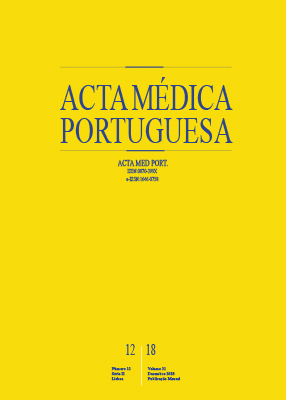Subclinical Hypothyroidism on the Elderly
DOI:
https://doi.org/10.20344/amp.10991Keywords:
Aged, Hypothyroidism/diagnosis, Reference Values, Thyroid Function TestsAbstract
Introduction: Subclinical hypothyroidism, defined as an increase of thyroid stimulating hormone levels with normal levels of thyroid hormones, could have a multiorgan impact. There seem to be differences in the elderly (over 65 years of age) which indicate that there should be a different approach in terms of diagnosis and the treatment.
Material and Methods: Electronic database search and narrative bibliographical review.
Results: Different case studies showing the multiorgan consequences of subclinical hypothyroidism suggest that, in the elderly, there is a minor impact or even a lack of repercussion, especially in those over 80 - 85 years old. Additionally, there is evidence indicating that the levels of thyroid stimulating hormone rise with the age of the patient. The standard treatment, in the beginning, is a low dose of levothyroxine when the levels of thyroid stimulating hormone are over 10.0 mIU/L, when there are noticeable symptoms or positive anti-thyroid antibodies. However, the treatment is not consensual when the levels of thyroid stimulating hormone are between 4.5 and 10.0 mIU/L, in such a way that the TRUST study concluded that no benefits have outcome from treating these patients.
Discussion: The non-definition of the reference range and the age gap are the key factors that contribute the most to biased results. However, there is consensus regarding non-treatment of mild thyroid dysfunctions (4.5 - 7.0 mIU/L) in the elderly, particularly above 80 years of age. Nevertheless, for positive anti-thyroid antibodies, suggestive ultrasound changes or iatrogenic side effects, the reference level should be 4.5 mIU/L.
Conclusion: The general impact of subclinical hypothyroidism is different in elderly people, meaning that an individualized therapeutic approach and long-term monitoring is the appropriate strategy.
Downloads
Downloads
Published
How to Cite
Issue
Section
License
All the articles published in the AMP are open access and comply with the requirements of funding agencies or academic institutions. The AMP is governed by the terms of the Creative Commons ‘Attribution – Non-Commercial Use - (CC-BY-NC)’ license, regarding the use by third parties.
It is the author’s responsibility to obtain approval for the reproduction of figures, tables, etc. from other publications.
Upon acceptance of an article for publication, the authors will be asked to complete the ICMJE “Copyright Liability and Copyright Sharing Statement “(http://www.actamedicaportuguesa.com/info/AMP-NormasPublicacao.pdf) and the “Declaration of Potential Conflicts of Interest” (http:// www.icmje.org/conflicts-of-interest). An e-mail will be sent to the corresponding author to acknowledge receipt of the manuscript.
After publication, the authors are authorised to make their articles available in repositories of their institutions of origin, as long as they always mention where they were published and according to the Creative Commons license.









